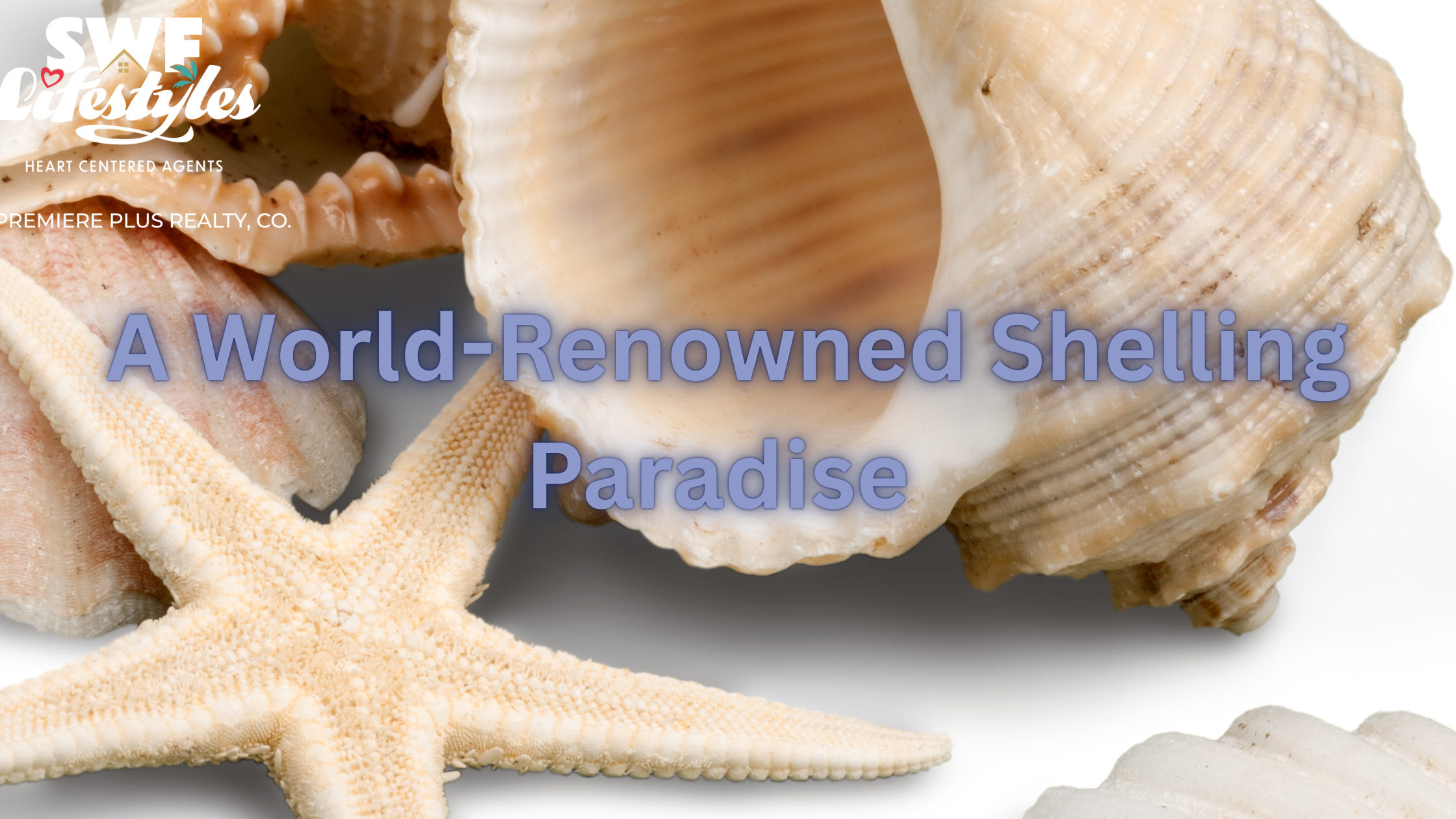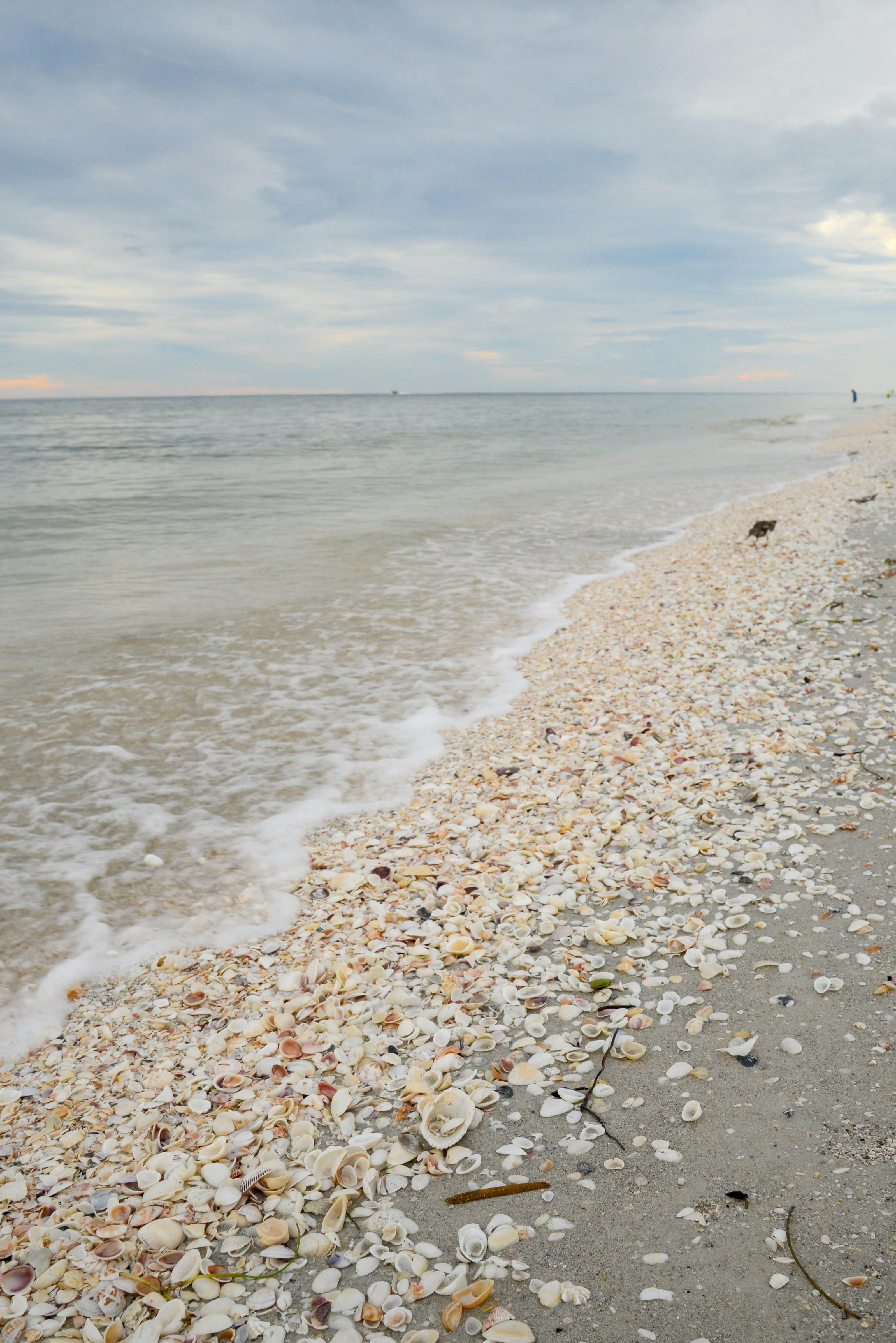Categories
Sanibel Island, sea shells, shelling, world-renowedPublished July 17, 2025
Sanibel Island: A World-Renowned Shelling Paradise

Sanibel Island, a barrier island off Southwest Florida, is famous for its shell-packed beaches and laid-back island lifestyle. In fact, shell lovers call Sanibel the “Holy Grail” of shelling – Travel & Leisure even ranked it the #1 U.S. shelling destination sanibel-captiva.org
Fig: A Sanibel beach at sunset, covered with the day’s bounty of shells. Sanibel’s gentle shelf and island shape mean many beaches are literally carpeted with seashells sanibel-captiva.orgsa
Shelling on Sanibel isn’t just a hobby – it’s a way of life. Beaches from the Sanibel Lighthouse (the East End) to Captiva’s north shore all yield world-class finds sanibel-captiva.org. Because the island slows storm-driven currents, shells accumulate in astonishing numbers sanibel-captiva.org. Even palm-frond “shell chandeliers,” shell-covered furniture and seashell souvenirs are island staples. Every tide, millions of shells wash in; long-time residents note that when they dig in backyard gardens, they often unearth conch, whelk and clam shells left behind from centuries of island turnover sanibel-captiva.orgsan
Shell Treasures: Junonia, Lightning Whelks, Alphabet Cones & More
Among the hundreds of shell types on Sanibel’s shores, some stand out as local celebrities. Junonia (Scaphella junonia) is the trophy shell here – a thick, cream-colored volute with characteristic brown spots. Junonias are extremely rare (they live 40–60 ft underwater), and finding even a fragment is big news. In fact, the world’s largest Junonia ever found came from Florida, and today resides in Sanibel’s shell museum sanddollarshelling.com. Lucky shellers hope storms or shrimp boats will wash up a Junonia on Sanibel’s beaches, but whole examples take years to appear. When one does, it’s social-media-worthy!
Other common favorites include the lightning whelk (Sinistrofulgur sinistrum), a large spiral shell notable for its left-handed opening. Lightning whelks can exceed a foot long and live for many years floridamuseum.ufl.edu. In fact, one of the largest lightning whelk shells in the world is on display right here at Sanibel’s Bailey-Matthews National Shell Museum floridamuseum.ufl.edu. These heavy, stout shells have jagged brown lines on their whorls, and they were even used by the native Calusa people as tools and ceremonial objects.
One of the most exotic finds is the Alphabet Cone (Conus spurius), a small cone-shaped shell with intricate letter-like patterns. Each Alphabet Cone’s markings are unique – enthusiasts say they often spell out English letters or words like nature’s own hieroglyphics treasureseekerssh
Of course, Sanibel yields many other types: shell-on conches, colorful tulip shells, scallop half-shells, olive snails, murex spines, sand dollars and more appear daily. In general, smaller and delicate shells (like mini scallops and coquinas) wash up in huge numbers, while larger rarities (like Junonia) come only sporadically. Locals often say: “Small shells are everywhere; big prizes are few.” But even among the common finds are beautiful specimens, and every sheller loves scanning for something unique. As one expert put it, Sanibel and nearby Captiva are “littered with shells…like a magnificent work of shell art created over thousands of years”sanibel-captiva.org.
Fig: Beachcombers’ loot from Sanibel can include scores of shells each day. Shell types commonly seen include horse conchs, whelks, coquinas, cockles and sometimes rarities like the Junonia (right) or Alphabet cone (bottom)sanibel-captiva.orgtre
Best Beaches & Shelling Tips
Almost any Gulf-side beach on Sanibel or Captiva will deliver shells, but some spots have earned reputations. Bowman’s Beach (on the west end of Sanibel) and Lighthouse Beach Park (on the east end) are longtime favorites for shellers. Bowman's offers plenty of parking and long stretches of shells, while the Lighthouse area (near the bayou) often yields a mix of shells plus birds or dolphins. Many shellers also walk along Tarpon Bay Road (middle of island) or charter boat tours to sandbars on North Captiva for big finds. In general, island shelling is so rich that even a casual stroll often brings dozens of shells picked up per minute.
Timing makes a difference. The best shelling is at low tide, especially during a spring “King Tide” (full or new moon) when the water is lowest sanibel-captiva.org. Early morning after the tide recedes is ideal, as storms overnight can also wash fresh shells ashore. In fact, many locals plan their shelling trips around passing weather fronts; strong onshore winds or a little tropical disturbance can dump a new layer of shells on the beach. Conversely, if the surf is calm and high, many shells stay underwater or get carried out to sea.
Shelling is easy but a little technique helps. Bring a bucket or mesh bag and shoes: simply shuffle your feet in the surf or pick through the wet sand, uncovering partly buried shells sanibel-captiva.org. Wearing flip-flops or water shoes is wise, because shells can be sharp. If you want to get serious, some people carry a small net or even a trowel. The main trick is patience – with millions of shells on each shore, anything you spot is likely there because it’s special. Locals say to “look carefully, there’s almost always more underneath”. And remember: Florida shelling law requires you to leave protected live creatures in the water and take only unoccupied shells.
In short, just pace along the drift line and you’ll steadily fill your bag. On an average outing, even a newcomer might gather hundreds of assorted shells. One thing’s for sure: you’ll never run out of shells to see or sweep up on Sanibel’s beaches sanibel-captiva.org!
Where to Stay: Island Resorts, Inns & Vacation Homes
Visiting Sanibel or Captiva offers a range of accommodations – from luxury resorts to cozy beach cottages. Many top resorts sit right on the beach, offering direct Gulf views and shell access. For example, the Sundial Beach Resort & Spa (on West Gulf Drive) is a classic family resort with multiple pools, a spa, fitness center, tennis courts and several restaurants sanibel-captiva.org
Fig: Many Sanibel/Captiva hotels are right on the beach. This aerial shot (above) shows a typical island resort with Gulf frontage, pool and tennis courts. Resorts on Sanibel and nearby Captiva offer modern amenities — beachfront pools, fitness centers, on-site restaurants — plus free Wi-Fi for business travelers sanibel-captiva.orgma
On the Captiva side, Tween Waters Island Resort is a longtime favorite (once owned by Arthur Conan Doyle) with a relaxed oceanfront hotel and colorful cottages. For more privacy, visitors also rent seaside cottages or condos. In fact, the islands have 50+ condo rental companies and 50+ vacation home rental agencies sanibel-captiva.org, so groups can book multi-bedroom houses with kitchens and decks. These vacation rentals often include fast Wi-Fi (great for remote workers/CEOs), barbecue grills, bicycles and full kitchens – ideal for families or executives who want a home-away-from-home feel on the beach.
Even Sanibel’s smaller inns and cottages are comfortable. Many are “island style” – low-rise buildings surrounded by palm trees and gardens. Dozens of these boutique inns boast free bikes, Wi-Fi, shuttle service and beach amenities sanibel-captiva.org. And one unique rule on Sanibel: no building is taller than the tallest tree sanibel-captiva.org. That means no skyscrapers interrupting island views – every hotel feels tucked into nature, often with panoramic beach vistas. Whether you prefer an upscale waterfront hotel or a charming cottage with kitchen, Sanibel lodging is famously hospitable and amenity-rich.
For a premium beachfront experience, some visitors even stay in nearby Fort Myers and ferry over. For example, the Marriott Sanibel Harbour Resort & Spa (in Punta Rassa) sits on 85 scenic acres overlooking the islands marriott.com. It offers spa services, multiple pools, and balconies with sweeping views – all just a short drive from Sanibel’s beaches. Even here the emphasis is on island-style tranquility: “a lush, tropical retreat with beautiful beaches, world-class shelling and top attractions,” as Marriott’s site touts marriott.com. In-room high-speed Wi-Fi, meeting rooms and fine dining mean business travelers can mix leisure with work easily.
Living the Island Life: Nature, Community & Access
Beyond shelling, Sanibel’s true charm lies in its overall lifestyle. The island is a preserved natural paradise – over half of Sanibel’s acreage is protected land or wildlife refuge. The famous J.N. “Ding” Darling National Wildlife Refuge covers thousands of acres of mangroves and salt flats, home to egrets, herons, and even roaming alligators and manatees. Beachcombing after sunset or biking along 22 miles of shaded bike paths are daily routines here. Residents and visitors alike spend afternoons kayaking through mangrove tunnels, birdwatching at dawn, or strolling quiet beaches. In short, the “local lifestyle” is deeply connected to nature mcmurrayandmembers.comsa
The town itself has a small-town, friendly vibe. There are no traffic lights on the entire island sagerealtor.com, and many national chain stores and fast-food franchises are prohibited by ordinance. This helps Sanibel retain its laid-back character: think pastel-painted cottages, local seafood restaurants and mom-and-pop shops. Weekly farmers markets and family-friendly events add to the community spirit. Islanders will tell you they appreciate this charm – as one Realtor put it, Sanibel and Captiva are “islands of many sanctuaries,” with friendly neighbors and plenty of local support sagerealtor.comsagereal
For people thinking of moving here, Sanibel offers a relaxed pace but modern convenience. Daily amenities (groceries, clinics, banks) are on-island, while bigger stores, hospitals and the Southwest Florida International Airport (RSW) are just a 30–45 minute drive away. Thus access to the mainland is easy – you can hop on the causeway and be in Fort Myers for work or airport connections quickly. (Note: a small toll is charged to cross the causeway each way, which locals say is a small price for island life sagerealtor.com.) Commutes to the mainland are minimal, traffic is rare, and the lack of lights/stop signs keeps driving stress-free.
In summary, Sanibel isn’t just a phenomenal beach for shells – it’s a place where outdoor living and community go hand-in-hand mcmurrayandmembers
Whether you’re planning a vacation or considering a move to Southwest Florida, Sanibel Island offers a unique blend of natural beauty, quiet community charm, and world-class shelling. It’s not just where you stay that makes a trip here special, but how life on the islands makes you feel. In every gentle wave and perfectly spiraled shell, Sanibel invites you to slow down, explore, and embrace the tranquil Florida coast.
Sources: Official Sanibel-Captiva visitor information sanibel-captiva.org





